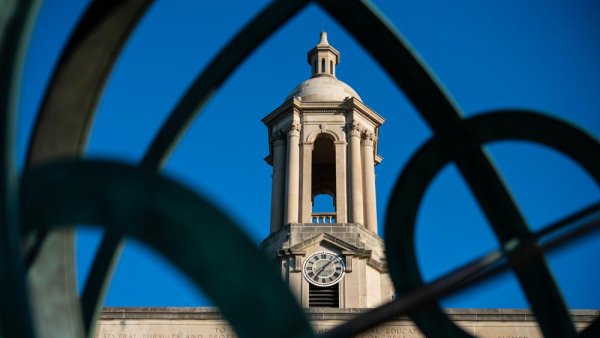IEE faculty, staff, and projects in the news
$1.95M NSF grant to fund novel study of environmental DNA fate in streams
| psu.edu
A bottle of water sampled from a lake or river can reveal what fish, amphibians insects and bacteria are present, thanks to environmental DNA, the genetic material shed by organisms. This way of measuring transforms scientists’ ability to determine the extent of aquatic life in various water bodies, according to a team led by Daniel Allen, assistant professor of aquatic ecology in Penn State’s College of Agricultural Sciences.
Mentions
-
Daniel Allen
-
Arial Shogren
 Arial Shogren
Arial Shogren
Professor, alumnus receive Vertical Flight Society’s outstanding technical paper award
| news.engr.psu.edu
Mentions
Climate change, cities, and net-zero emission buildings
Despite their small geographical footprints, cities incorporate a high density of buildings and great concentration of urban residents, making them the hotspots of resource and energy consumption and greenhouse gas emissions.
Penn State welcomes new cohort of Emerging Academic Leaders for fall 2024
| psu.edu
Penn State has announced the selection of 23 faculty members for the Penn State Emerging Academic Leaders program for fall 2024. This initiative highlights individuals who have demonstrated exceptional potential for academic leadership and innovation within their fields.
Mentions
-
Charles Anderson
-
Seth Blumsack
-
Vikash Gayah
-
Carter Hunt
-
Siela Maximova
-
Erica Smithwick
-
Joseph Ranalli
-
Derrick Taff
-
Hong Wu
-
Mallika Bose
-
Lara Fowler
-
Andrew Read
-
Craig J. Newschaffer
Raymond E. and Erin Stuart Schultz Dean, College of Health and Human Development -
Marie Hardin
Ancient seeds reveal plant migration path from Asia to Australia
| earth.com
Giant fossil seeds reveal ancient plant migration from Asia to Australia, shedding light on Eocene rainforest evolution. This article features Penn State research.
Mentions
Scott named associate director of Institute of Energy and the Environment
| psu.edu
Christopher Scott, a researcher with more than three decades’ experience in international and domestic water, food and energy policy, has been named an associate director of the Institute of Energy and the Environment at Penn State.
Mentions
-
Christopher Scott
Associate Director & Thematic Area Lead, Water Sustainability, Institute of Energy and the Environment -
Bruce Logan
-
Erica Smithwick
-
Michael Janik
Associate Director & Thematic Area Lead, Integrated Energy Systems, Institute of Energy and the Environment
Early life exposure to common chemical permanently disrupts gut microbiome
| psu.edu
Early life exposure to "forever chemicals" in the environment permanently disrupts the gut microbiome in mice, contributing to the development of metabolic disease in later life, according to a new study led by Penn State researchers. The results suggest that human exposure to these chemicals during early childhood may be contributing to the recent epidemic of metabolic disorders, including obesity and Type 2 diabetes among adults.
Mentions
University Libraries Open Publishing launches open-access journal ‘Geomorphica’
| psu.edu
Penn State University Libraries Open Publishing has launched Geomorphica, a Diamond Open Access journal that promotes discourse and disseminates research in geomorphology.
Mentions
Researchers use CT scanning to study spotted lanternfly anatomy
| psu.edu
Because basic knowledge about the spotted lanternfly's biology remains limited, a team of Penn State researchers is collaborating with the Center for Quantitative Imaging to detail the spotted lanternfly's anatomy and physiology.
Mentions
Researchers, staff work with Pittsburgh municipalities to predict geohazards
| psu.edu
Penn State students, Carnegie Mellon students, Penn State faculty and staff from the Franco Harris Pittsburgh Center at Penn State are collaborating to use existing fiber optic cables to predict dangerous geohazards like flooding, landslides and sinkholes in Pittsburgh. They're also asking for the community's help.
Mentions
Texas reservoir water levels are hitting record lows. Here's why
| newsweek.com
As of August 7, Amistad International Reservoir is 25.2 percent full, and Falcon International Reservoir is 13.3 percent full. This article quotes Erica Smithwick, Distinguished Professor of Geography, and Antonia Hadjimichael, assistant professor of geosciences.
Mentions
Giant fossil seeds from Borneo record ancient plant migration
| psu.edu
Ancient fossil beans about the size of modern limes, and among the largest seeds in the fossil record, may provide new insight into the evolution of today’s diverse Southeast Asian and Australian rainforests, according to Penn State researchers who identified the plants.
Mentions











































